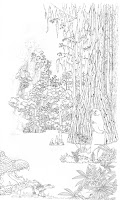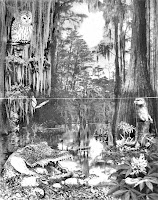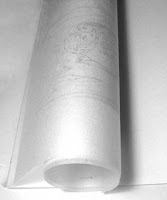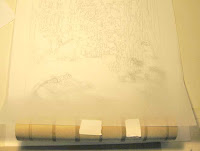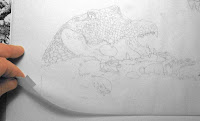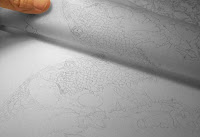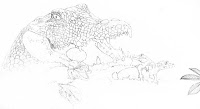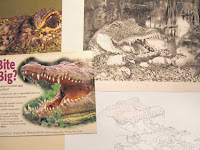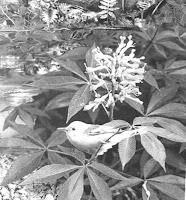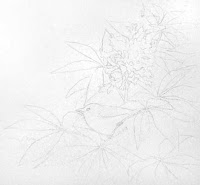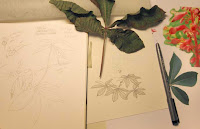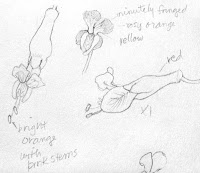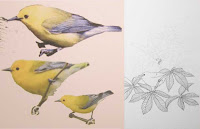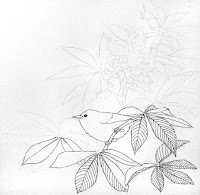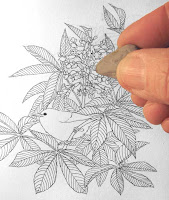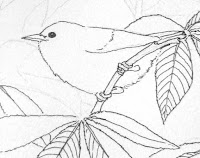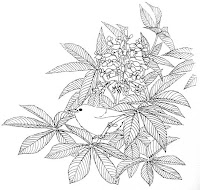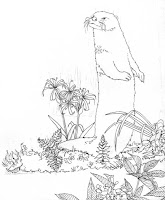This was a VERY small class. 
I usually require a minimum of five students, but only four signed up for this one, and since sometimes a hopeful participant will drop by at the last minute and ask if there's still room (that's chancey ~ sometimes there isn't), I decided to go ahead and set up for the class at The Grove, a nice classroom with great north light and pretty good ambience for a public meeting place. (There's also a microwave and sink, perfect for hot lunch-making.)
Maybe

my low attendance was a result of the fact that this was the first workshop of the season and the catalog had just been out for a bit over a week ~ and then it required the students to come on two weekends, one of which was Memorial Day (duh!). I think I still have some things to learn about scheduling. . . .
In the end, though, I wasn't sorry I went ahead with it. The three women, Esther, Eileen and Darrelle, who came for the class were a pure delight. My fourth student never appeared ~ imagine that!
DAY ONE ~ Sketch in Your  Journal
JournalAs usual, we started out with an examination of various types of sketchbook/journals. My Hawaii journal from Christmas 2007 and my Costa Rica journal from last February got us all in the mood, and I jumped right into teaching them how to make their own journals lively with
both sketches and creative writing.
After some basic

right-brain exercises I had them do contour drawings of one hand. This is done without looking at the paper, so sometimes the results are a little goofy.
I was intrigued with the one Eileen did ~

she was having such fun she drew around the outline of her hand twice without looking!
Then they each tried a contour drawing of a shell, drawn right in the workbook ( I always provide the workbooks to keep things on track and give my students something to take home to consult later), first without looking at their drawings, then another drawing, glancing at both the shells AND their drawings as they drew.
By
then


they had acquired

enough confidence to try drawing a leaf, and the results were quite fine, don't you think? Eileen and Esther claim to be beginning artists, and Darrelle is, in her estimation, between beginner and intermediate. Check these drawings out ~ they were done in about
fifteen

minutes.
After lunch

we studied journal page design for awhile, looking at good and poor design, some interesting ways
to design journal pages, and all manner of things to attach or include in a journal. Then I got out my box of seashells so that each could select one to draw. I also handed out free-form shapes to trace around onto their journal page, into which they could write a journal entry. This is a good way to start thinking "out of the box " of boring square paragraphs with nicely justified edges, etc. I was pleased to see that these

students scarcely needed the push.
We did quite a few other things, as well, learning how to draw pinecones, shading techniques, and other interesting things. All too soon, the day
was done and we folded up for the afternoon.
DAY TWO ~ Journal in Your SketchbookI started out Day 2 with an example of how creative writing can turn a boring journal entry into a sensual delight: My boring entry read: "5/28, planted 2 ponypacks of snap peas"
The improved creative entry started out:

"It's sunny today with a slight breeze, and the blossoms on the madrone trees fill the air with a sweet honey scent..." etc., continuing for a couple more paragraphs.
The creative entry has a quick contour drawing of the baby pea plants, then a more detailed one colored with watercolor pencils. There's even a haiku under one drawing:
I

had them close their eyes as I read it to them, so they could more easily imagine the honey-sweet scent of the madrone flowers, a visit from the cat ("The chickenwire keeps Jesse-cat out of the pot ~

he thinks those pots are there for his own personal use."), and the taste of a crisp pea leaf.
Then we did an exercise of drawing-then-journaling about a subject, later creating a haiku, then a poem. The students showed some extraordinary talent here. I was impressed with their efforts.
Later in the day they did some more sketching, then tried their hand at some basic calligraphy, and

the "fun font" I have designed. This font makes it easy to add a light-hearted, splash-dash title or caption to a page. We also did some fancy initial caps, which can

really add interest to an entry. I was working along with them, demonstrating ways to decorate, design, and add interest to a journal page with fonts, initial caps, sketches and borders.
We also studied journaling in blog form, how to turn blog entries into journal pages, and

using ephemera to add interest to a journal page. Our next class would be the following Saturday, and I meant to assign some homework, but I forgot. Phoo.
Eileen has created some gorgeous journal books, but has

been too intimidated by her lack of drawing skills to use them. She brought some for us to look at ~ stunning works of art! I hoped she was gaining some confidence in her drawing skills. They ALL were far more skilled artists by the end of this second day than they were that first morning, and, I think, a bit surprised by their improvement. I'm pleased with their progress.
DAY THREE ~ Color Your SketchesThe final day was Color Day. We started out with a step-by-step examination of how to use watercolor pencils. I broke out the watercolor pencils (I must have 150 pencils, all colors) with which they created a rainbow of colors and mixtures on the

color wheel printed in their workbooks. Then they experimented with the waterbrushes (these are paintbrushes with water in the barrell ~ perfect for travel sketching. Darrelle sketched one on her leaf page above.), blending and creating new colors by mixing.
To keep i

t from getting too intense, we then sketched for a few minutes, repeating the contour drawing of the shell done the previous week. The repeat exercise is very revealing ~ this time their confidence in their capability is marked, and the results are faster and better.
Then it was Orchid Coloring-book Time. I've printed an outline of an orchid in the workbook, with the photo from which I drew it. The assignment is to add color as it appears in the photo.

This is a really easy way to get comfortable with the watercolor pencil, choosing and applying color with the pencils, and the various ways of using a paintbrush to get desired results.
I did

an extensive demo of things they needed to know how to do, then worked at coloring an orchid drawing along with them, demo-ing as I worked. It's good to have a demo first, but some of the information doesn't soak in until they try to do it themselves. Their results were quite good, and they learned enough to get enough self-assurance to tackle the afternoon's project: to draw a pepper then watercolor pencil/paint it.
Eileen had brought a number of fascinating art

pieces she had acquired as part of an art-creating/sharing group. She gave us a mini-talk as we ate our lunch and admired the pieces. She also brought a microwave plant press to show us, with which she has pressed flowers in just minutes. I want one, and googling it online I discovered that our local
Northwest Nature Shop carries them! Yes!
During the afternoon, for a break, I had the ladies draw some foliage shapes,

then add light and shadow colors to them. That was a really popular exercise, because they learned some ways to make foliage look real without having to draw or color every leaf
Then they each chose a pepper and we started The Pepper Project (sometimes I use apples or gourds, whatever colorful things I find at the grocery store). As before, I worked alongside them, lightly, so that I could experience what they were were going through, and so that they could glance over to see how I was handling the different steps.

This works really well if the instructor doesn't get too involved in his/her own art.
I had to make sure I stayed involved with all the students' drawings/paintings so that I could advise and help them resolve problem areas. When I have a
lot of students I don't work along with them, but hold up an occasional student's work as a good example of what the others should be working for ~ or if no one has quite the right approach, I can do a quick example as a demo. With this small a group, though, it was good to not be hanging over their shoulders all the time, so drawing and painting my own pepper worked out well.
Here are the results, Esther, Eileen, and Darrelle,



in that order ~ three very different styles, all of them extremely nice. I was sorry the day had to end, and I think the ladies were, too. We had shared many stories, jokes and hearty laughs throughout the day, and it was a wrench to see it finish.
So that's the workshop. Lots of things happened during the three days that didn't make it into this blog, but you can get the feel of it, I hope. I'm doing my
Nature Sketching and Landscape Drawing Workshop in a couple of weeks, June 21-22 and 28. Come join us if you can. I have four people signed up so far.
And if you still haven't planned your summer workshop vacation, there is still room in my
Costa Rica Journaling Workshop for more students! This is the workshop of a lifetime, and I feel so fortunate to be able to share it. Come join us July 7-10!
 It was quite a journey, but I've gotten the ink all on the paper, the underlying pencil lines erased, and although it took two scans to get the whole thing into graphic files (which I then merged using Photomerge and some persnickety personal tweaking since it wasn't perfect), it is now the single image which you see here.
It was quite a journey, but I've gotten the ink all on the paper, the underlying pencil lines erased, and although it took two scans to get the whole thing into graphic files (which I then merged using Photomerge and some persnickety personal tweaking since it wasn't perfect), it is now the single image which you see here. I don't know what would happen if I get totally carried away with the water. On the other hand, I don't want to do that anyway because this is on unmounted Bristol board, which is only a little heftier than the weight (and texture) of a file card.
I don't know what would happen if I get totally carried away with the water. On the other hand, I don't want to do that anyway because this is on unmounted Bristol board, which is only a little heftier than the weight (and texture) of a file card. 
